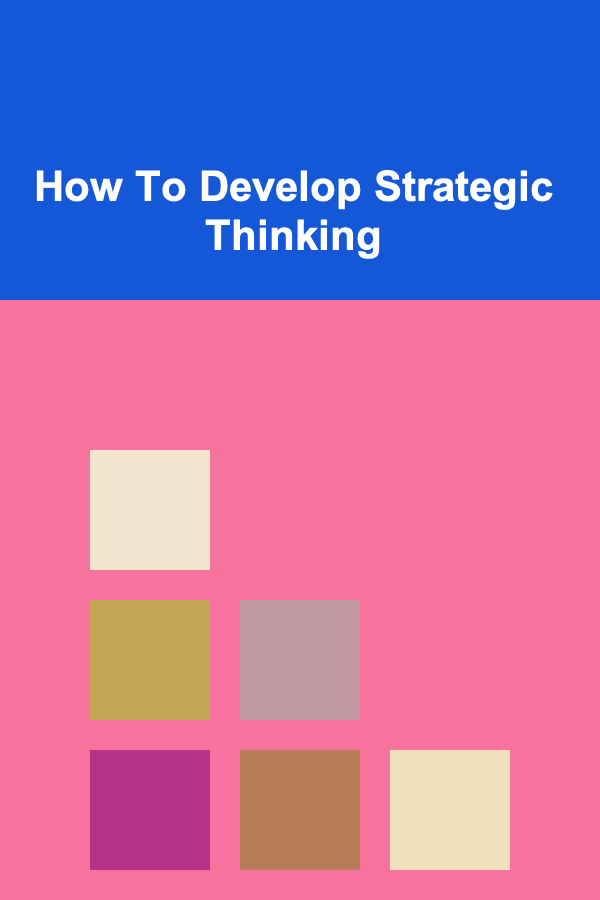
How To Develop Strategic Thinking
ebook include PDF & Audio bundle (Micro Guide)
$12.99$9.99
Limited Time Offer! Order within the next:

Strategic thinking is a vital skill in personal development, leadership, and organizational success. It involves the ability to anticipate, plan, and adapt in ways that align with long-term goals, even in the face of uncertainty or unforeseen challenges. It is not just about solving immediate problems, but about considering the broader picture and understanding how decisions today will shape the future. Developing strategic thinking requires a shift in mindset, a combination of analytical skills, creative thinking, and a deep understanding of both internal and external environments.
In this article, we will explore the concept of strategic thinking, why it's essential, and how to develop it effectively. We will look at the underlying principles, key habits, and actionable steps that anyone can take to strengthen their strategic thinking skills.
Understanding Strategic Thinking
Strategic thinking is not a one-off activity but a continuous process of evaluating and making decisions that affect long-term outcomes. While it's often associated with top-level management or executives, strategic thinking is equally important at all levels of an organization or even in one's personal life. It involves asking the right questions, making informed decisions, and positioning oneself or an organization for future success.
At its core, strategic thinking revolves around the ability to:
- See beyond the present moment: Strategic thinkers view the long-term implications of their actions and decisions.
- Analyze complex situations: They break down complicated problems into manageable parts and understand the key drivers that influence outcomes.
- Adapt to changing circumstances: They embrace flexibility and are able to pivot when conditions evolve or new opportunities arise.
- Make decisions based on data and foresight: Instead of acting on impulse, strategic thinkers use information and foresight to make calculated moves.
Strategic thinking blends several disciplines, including analysis, foresight, intuition, and creativity. It is about continuously refining the way you approach challenges and understanding that there are often multiple pathways to success.
Why Strategic Thinking Is Important
Strategic thinking can set apart the most effective leaders and organizations from the rest. Here are some reasons why it is essential:
A. Anticipating Change
One of the hallmarks of strategic thinking is the ability to anticipate change. This includes market shifts, changes in technology, and evolving consumer preferences. Leaders and individuals with strategic thinking skills are often better prepared for these changes, enabling them to act proactively rather than reactively.
For example, businesses that failed to recognize the potential of digital transformation in the early 2000s fell behind competitors who adapted early. A strategic thinker not only sees the current market but also anticipates where it is headed and takes steps to position themselves for the future.
B. Solving Complex Problems
Strategic thinking helps individuals and organizations approach problems from a higher level. Instead of focusing solely on the immediate issue, strategic thinkers zoom out to see the broader implications and causes. They are adept at solving complex, multifaceted problems that require a nuanced understanding of various interrelated elements.
C. Improving Decision-Making
Strategic thinking allows for better decision-making by evaluating alternatives based on long-term goals and objectives. Instead of being swayed by short-term distractions, strategic thinkers assess decisions through the lens of their broader vision and goals.
D. Competitive Advantage
In a competitive environment, whether in business or personal development, those who engage in strategic thinking are often better positioned to outperform others. By staying ahead of trends and making informed decisions, they create opportunities for growth, innovation, and success.
E. Leadership Effectiveness
Leaders who think strategically inspire trust and confidence in their teams. They can communicate the vision for the future, make tough decisions, and guide their teams through uncertainty. Strategic thinking equips leaders with the tools to align resources, talent, and efforts toward achieving organizational objectives.
Key Elements of Strategic Thinking
Strategic thinking is multi-faceted and can be broken down into several key elements. Developing proficiency in each of these areas will sharpen your overall strategic mindset.
A. Long-Term Vision
Strategic thinkers have a clear long-term vision and a deep understanding of how their current actions and decisions will influence future outcomes. This vision serves as the compass, guiding all other decisions and actions. A long-term perspective prevents them from getting bogged down by day-to-day operations or short-term setbacks.
Actionable Tip: Develop a clear set of long-term goals. These can be personal goals, business objectives, or organizational targets. Make sure these goals are measurable and time-bound, and ensure every decision aligns with them.
B. Analytical Thinking
Strategic thinkers are analytical by nature. They break down complex scenarios, identify key variables, and use data to inform their decisions. Analytical thinking helps strategic thinkers evaluate potential risks and rewards and weigh the pros and cons of different alternatives.
Actionable Tip: Work on strengthening your analytical skills by regularly reviewing trends, data points, and case studies relevant to your field. Develop a habit of looking at problems from multiple perspectives and use frameworks to analyze them.
C. Creativity and Innovation
While analysis is important, creativity is equally vital. Strategic thinking isn't just about solving problems using existing methods---it's about finding new, innovative solutions. Creative strategic thinkers are not confined by traditional approaches and are always looking for new ways to address challenges.
Actionable Tip: Practice creative thinking by brainstorming ideas without judgment. Engage in activities that encourage outside-the-box thinking, such as role-playing different scenarios or solving hypothetical problems. Surround yourself with diverse perspectives to stimulate innovation.
D. Foresight
Foresight is the ability to predict future trends and outcomes. Strategic thinkers develop foresight through a combination of experience, intuition, and knowledge of external factors such as market conditions, technology advancements, and social trends. This foresight allows them to anticipate potential challenges and capitalize on emerging opportunities.
Actionable Tip: Regularly read about trends in your industry, society, and the global economy. Develop a habit of scenario planning to explore how different events or changes could impact your goals. Consider both optimistic and pessimistic future scenarios.
E. Decision-Making
At the heart of strategic thinking is the ability to make decisions. Good strategic decision-making involves understanding both the immediate and long-term consequences of each option, gathering necessary information, and choosing the best course of action. Strategic decisions require not just analytical thinking, but also the courage to make tough choices and take calculated risks.
Actionable Tip: Improve your decision-making skills by practicing a decision-making framework, such as the SWOT analysis (Strengths, Weaknesses, Opportunities, Threats), to evaluate different options. Learn to make decisions based on both logic and intuition.
How to Develop Strategic Thinking
Now that we understand the key elements of strategic thinking, let's look at the steps you can take to develop these skills.
A. Step 1: Cultivate a Growth Mindset
Strategic thinking is not something that comes overnight. It requires time, effort, and a willingness to learn. Cultivating a growth mindset is the first step to becoming a better strategic thinker. This means being open to new ideas, feedback, and the possibility of change.
Actionable Tip: Embrace learning opportunities, seek mentorship, and challenge your assumptions. When faced with setbacks, view them as opportunities for growth rather than failures.
B. Step 2: Regularly Step Back and Reflect
In the hustle and bustle of daily activities, it's easy to become absorbed in the present moment. However, strategic thinking requires taking regular breaks to step back and reflect. By doing so, you can evaluate your progress, reassess your goals, and adjust your approach as needed.
Actionable Tip: Set aside time each week for reflection. Use this time to review your goals, the decisions you've made, and their outcomes. Ask yourself whether your current actions align with your long-term vision.
C. Step 3: Develop a Habit of Continuous Learning
To think strategically, you must constantly seek knowledge and broaden your perspective. The more information you gather, the better equipped you will be to understand complex situations and predict future trends.
Actionable Tip: Engage in continuous learning by reading books, attending seminars, and networking with experts in your field. Subscribe to journals or newsletters that focus on strategic thinking and related subjects.
D. Step 4: Build Your Analytical and Problem-Solving Skills
Strategic thinking requires the ability to analyze complex situations and identify solutions. Strengthen your analytical and problem-solving skills by regularly working on puzzles, case studies, or real-world scenarios.
Actionable Tip: Practice using frameworks like SWOT, PEST analysis (Political, Economic, Social, Technological), or Porter's Five Forces to evaluate different situations. Apply these frameworks to your personal and professional life to sharpen your analytical skills.
E. Step 5: Learn from Others
Strategic thinking is often developed by observing and learning from others. Study successful leaders, organizations, or mentors who exhibit strategic thinking. Understand their thought processes and how they approach challenges.
Actionable Tip: Find a mentor who excels at strategic thinking and ask for their guidance. Alternatively, analyze case studies of successful companies or leaders and extract lessons that you can apply to your own life.
F. Step 6: Take Risks and Embrace Uncertainty
Finally, strategic thinkers are not afraid of taking calculated risks. They understand that uncertainty is a natural part of strategic thinking, and they are willing to make bold decisions when necessary. Strategic thinking requires the courage to act when the future is unclear.
Actionable Tip: Start by taking small risks in areas where you feel comfortable, then gradually move to bigger decisions. Weigh the risks and rewards carefully, but don't let fear hold you back from making decisions that can drive long-term success.
Conclusion
Strategic thinking is an essential skill that can propel you to new heights in your personal and professional life. By developing long-term vision, analytical skills, creativity, and foresight, you can position yourself to thrive in a rapidly changing world. Through continuous learning, reflection, and practice, you can master the art of strategic thinking and make better decisions that align with your long-term goals.
Reading More From Our Other Websites
- [Personal Finance Management 101] How to Effectively Create a Family Budget That Includes Unexpected Expenses
- [Home Space Saving 101] How to Use Slimline Furniture for Space-Saving in Small Homes
- [Personal Finance Management 101] How to Teach Kids About Money and Finance from a Young Age
- [Scrapbooking Tip 101] From Photos to Keepsakes: Step-by-Step Mini Scrapbook Layouts
- [Home Soundproofing 101] How to Create a Peaceful Retreat with Home Soundproofing
- [Home Space Saving 101] How to Declutter Your Entryway: Essential Small Entryway Furniture for Compact Spaces
- [Home Party Planning 101] How to Plan a Successful Potluck Party at Home
- [Personal Care Tips 101] How to Style and Care for Curly Hair: A Comprehensive Guide
- [Personal Care Tips 101] How to Apply Foundation to Sculpt and Contour Your Face
- [Home Maintenance 101] How to Maintain Your Home's Hot Tub and Pool Equipment

Effective Strategies for Executive Coaches: Transforming Leaders and Organizations
Read More
How to Reduce Your Debt with a Strategic Plan
Read More
How to Set Up a System for Regular Decluttering
Read More
How to Soundproof Your Home's Interior Doors
Read More
How To Write a Resume That Highlights Remote Work Skills
Read MoreHow to Use a Bill Payment Tracker App for Financial Peace
Read MoreOther Products

Effective Strategies for Executive Coaches: Transforming Leaders and Organizations
Read More
How to Reduce Your Debt with a Strategic Plan
Read More
How to Set Up a System for Regular Decluttering
Read More
How to Soundproof Your Home's Interior Doors
Read More